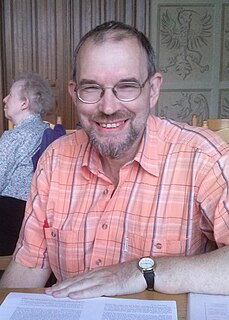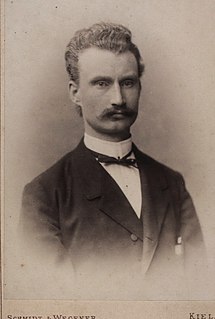Related Research Articles

The Afroasiatic languages, also known as Hamito-Semitic, or Semito-Hamitic, and sometimes also as Afrasian or Erythraean, are a language family of about 300 languages that are spoken predominantly in Western Asia, North Africa, the Horn of Africa, and parts of the Sahara/Sahel. With the exception of its Semitic branch, all other branches of the Afroаsiatic family are spoken exclusively on the African continent.

Nostratic is a hypothetical macrofamily, which includes many of the indigenous language families of Eurasia, although its exact composition and structure vary among proponents. It typically comprises Kartvelian, Indo-European and Uralic languages; some languages from the disputed Altaic family; the Afroasiatic languages spoken in North Africa, the Horn of Africa, the Arabian Peninsula and the Near East as well as the Dravidian languages of the Indian Subcontinent.
Allan R. Bomhard is an American linguist.
Mass comparison is a method developed by Joseph Greenberg to determine the level of genetic relatedness between languages. It is now usually called multilateral comparison. The method is rejected by most linguists, though not all.

Indo-European studies is a field of linguistics and an interdisciplinary field of study dealing with Indo-European languages, both current and extinct. The goal of those engaged in these studies is to amass information about the hypothetical proto-language from which all of these languages are descended, a language dubbed Proto-Indo-European (PIE), and its speakers, the Proto-Indo-Europeans, including their society and Proto-Indo-European mythology. The studies cover where the language originated and how it spread. This article also lists Indo-European scholars, centres, journals and book series.
Insular Celtic languages are the group of Celtic languages of Brittany, Great Britain, Ireland, and the Isle of Man. All surviving Celtic languages are in the Insular group, including Breton, which is spoken on continental Europe in Brittany, France. The Continental Celtic languages, although once quite widely spoken in mainland Europe and in Anatolia, are extinct.
The Indogermanisches etymologisches Wörterbuch was published in 1959 by the Austrian-German comparative linguist and Celtic languages expert Julius Pokorny. It is an updated and slimmed-down reworking of the three-volume Vergleichendes Wörterbuch der indogermanischen Sprachen.

Indo-Uralic is a controversial hypothetical language family consisting of Indo-European and Uralic.
Holger Pedersen was a Danish linguist who made significant contributions to language science and wrote about 30 authoritative works concerning several languages.

Borean is a hypothetical linguistic macrofamily that encompasses almost all language families worldwide except those native to sub-Saharan Africa, New Guinea, Australia, and the Andaman Islands. Its supporters propose that the various languages spoken in Eurasia and adjacent regions have a genealogical relationship, and ultimately descend from languages spoken during the Upper Paleolithic in the millennia following the Last Glacial Maximum. The name Borean is based on the Greek βορέας, and means "northern". This reflects the fact that the group is held to include most language families native to the northern hemisphere. Two distinct models of Borean exist: that of Harold C. Fleming and that of Sergei Starostin.
Proto–Afroasiatic, sometimes also referred to as Proto-Afrasian, is the reconstructed proto-language from which all modern Afroasiatic languages are descended. Though estimations vary widely, it is believed by scholars to have been spoken as a single language around 12,000 to 18,000 years ago, that is, between 16,000 and 10,000 BC. The reconstruction of Proto-Afroasiatic is problematic and remains largely lacking. Moreover, no consensus exists as to the location of the Afroasiatic Urheimat, the putative homeland of Proto-Afroasiatic speakers.

Václav Blažek is a Czech historical linguist. He is a professor at Masaryk University and also teaches at the University of West Bohemia.
Rudolf von Raumer was a German philologist and linguist, known for his extensive research of the German language. He was the son of geologist Karl Georg von Raumer.

Uralic–Yukaghir, also known as Uralo-Yukaghir, is a proposed language family composed of Uralic and Yukaghir.
Semitic studies, or Semitology, is the academic field dedicated to the studies of Semitic languages and literatures and the history of the Semitic-speaking peoples. A person may be called a Semiticist or a Semitist, both terms being equivalent.

Hermann Möller was a Danish linguist noted for his work in favor of a genetic relationship between the Indo-European and Semitic language families and his version of the laryngeal theory.
Proto-Berber or Proto-Libyan is the reconstructed proto-language from which the modern Berber languages descend. Proto-Berber was an Afroasiatic language, and thus its descendant Berber languages are cousins to the Egyptian language, Cushitic languages, Semitic languages, Chadic languages, and the Omotic languages.

The Afroasiatic Urheimat is the hypothetical place where speakers of the proto-Afroasiatic language lived in a single linguistic community, or complex of communities, before this original language dispersed geographically and divided into separate distinct languages. This speech area is known as the Urheimat. Afroasiatic languages are today distributed in parts of Africa and Western Asia.

Vladimir Emmanuilovich Orël was a Russian linguist and etymologist.
Karl Penka was an Austrian philologist and anthropologist. Known for his now-outdated theories locating the Proto-Indo-European homeland in Northern Europe, Penka has been described as "a transitional figure between Aryanism and Nordicism".
References
- ↑ Compare the leading specialist of Afroasiatic Carleton T. Hodge (1998:318): "The positing of a genetic connection between Indo-European and Semitic goes back at least as far as Richard Lepsius (1836)".
- Adams, Douglas Q. and James Mallory. 2006. The Oxford Introduction to Proto-Indo-European and the Proto-Indo-European World. Oxford: Oxford University Press.
- Greenberg, Joseph H. 1950. "Studies in African linguistic classification: IV. Hamito-Semitic". Southwestern Journal of Anthropology 6.1, 47–63.
- Greenberg, Joseph H. 2005. Genetic Linguistics: Essays on Theory and Method, edited by William Croft. Oxford: Oxford University Press.
- Whitney, William Dwight. 1875. The Life and Growth of Language: An Outline of Linguistic Science. New York: D. Appleton & Co.